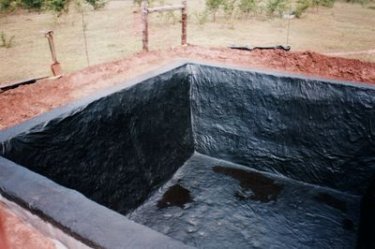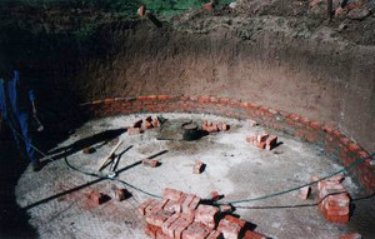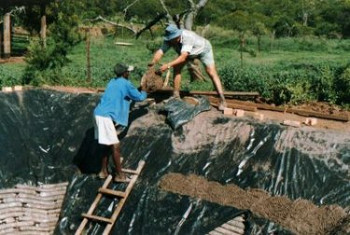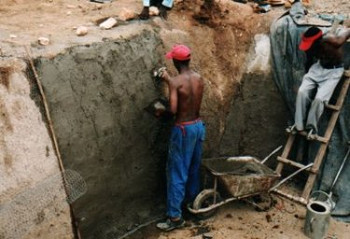A BIT MORE ABOUT IT - PRACTICAL DETAILS
 Photo of my Microfarm - 2002
Photo of my Microfarm - 2002
My wife, Tineke, took the snap
- The water supply, front left, a 50 m3underground tank lined with bitumen-coated geotextile and covered with horticultural shade-cloth, to store run-off during heavy showers of rain;
- The eleven 9m x 1m veg plots;
- Mbuzile, my right-hand man, centre-left, at the hand pump, who pumped water from the tank into the 200-litre oil drum in the dead tree, centre-right; water is fed from this drum to a 9-m length of perforated black plastic pipe that is moved to each plot in turn;
- The reed fence for protection against the frequent hot, dry, north-west winds of spring;
- The thatched dwelling for my wife, Tineke, and me;
- The composting toilet, extreme left, - the ultimate recycler.
"And what you can't see, the site's facts of life:
Altitude: 1,200m;
Average annual rainfall: 500mm - summer rain but highly erratic;
Latitude 30o S;
Only 200 frost-free days per year;
Deep 'duplex' soil of reasonable fertility;
11km from Queenstown (Pop 70,000) in Eastern Cape, South Africa"
How you can do it
|
|
For your Microfarm, first secure your WATER SUPPLY - you may think you have enough rain, but you will only get maximum production if your crop never suffers moisture stress and your animals have easy access to water.
Agricultural Projects depending on a communal water supply can be tricky. You can be left without water at a crucial stage owing to the action (or inaction) of just one family or committee. If you can't dig a well or get free access to a perennial surface source (dam, stream, wetland or river) or tap into an affordable and reliable public supply, then a hafir maybe the answer - an excavated storage tank such as is widely used along the southern edge of the Sahara in the Sudan. (See photo in 1. The Idea) |
|

50 m3 hafir lined with geotextile and bitumen
|
| |
Hafir
It is a hole in the ground dug out to store surface run-off during heavy rain. It doesn't require a special site as would a dam which stores water mostly above ground and so needs to be in a valley, but it will benefit from being sited next to a path, road or yard which generate extra run-off.
For a small one like ours that was hand-dug, the ground should be diggable to 2 metres.
It can be any size or shape: the nature of the lining material usually suggests the best shape and the nature of the soil suggests how steep the sides can be - from vertical (very efficient, but may collapse) to 45o.
Depth: the deeper the better to reduce evaporation loss, but for hand digging, 2m is about max. Go deeper and you have to double handle the spoil - hard work!
It will be filled from a catchment: the access track or path to the homestead is usually sufficient because such a degraded soil surface always sheds more water than it absorbs in a heavy shower. Roofs and a bare yard will also contribute as do degraded grazing areas and public lands!.
It will usually need an impervious lining since most soils are permeable. We used some geotextile on which we painted an aqueous bitumen emulsion for our first one in Eastern Cape. Reinforced rendered brickwork lined the second one and a polythene-clay sandwich lined the third one. PVC, butyl and HDPE sheeting and ferro-cement also work. Also a 4-ply clay - 150micron-polythene sandwich works well. It's messy but very cheap!
The cover can be reeds or maize and sorghum stalks made up into "mats" with sisal string and strung over the top: cheap and easy but short-lived and no protection against drowning accidents. We mainly used woven nylon horticultural shade cloth on plain steel wires strained across the hafir: good against mosquitoes, reduces evaporation about 80% and reduces risk of drowning accidents.
Water is drawn out by a bucket on a rope, a hand-pump or a simple electric pump (which can be solar powered for off-grid sites). |
| |
Suggested Starter Size & Plan of Microfarm:
| Area | | |
| Hafir: 5m x 5m x 2m deep | | 25 m2 |
| Space to dump spoil from hafir (plant trees on it? Space for chicken run?) | | 50 m2 |
| Veg Plots: 10 of 10 m x 1 m plots separated by 1/2m wide paths | | 150 m2 |
| Space for compost heaps etc | | 25 m2 |
| Space for small house, compost toilet, access, yard etc | | 100 m2 |
| Spare | | 50 m2 |
| TOTAL SPACE REQUIRED FOR A FAMILY MICROFARM | | 400 m2 |

60 m3 hafir under construction using 115 mm (4.5 inch) thick burnt brick side reinforced with 4 mm wire in each course and (later) plastered; floor reinforced with coarse wire netting
|

55 m3 hafir lined with plastic sheet-clay sandwich; clay being put into place; grey 'sausages' are poly-tubing filled with very weak cement-sand mix acting as revetment to stabilise and protect lining
| | 
50 m3 hafir at Jo Bobo's place in Thornhill, near Queenstown, S.Africa; cement plaster on wire netting lining; plastic sheet to assist proper curing of plasterwork
|
Growing Stuff:
Microfarms, being so small, are hand-worked, so the work can be done well - and as your soil improves with all that added organic matter - it becomes easier, as well as more productive!
See it like fielding a football team. The eleven players are:
- Good soil structure: whether you dig or don't dig (till vs no-till) add lots of organic material (compost, dung, mulch etc) and never walk on the plots when moist because that will compact the soil and spoil its structure.
- Good soil fertility: again, add compost, manure and mulch to ensure maintenance of good fertility, especially if it incorporates stuff like urine, ash (wood fire), burnt bones, animal slaughter waste besides usual garden "rubbish".
- Soil has enough calcium and phosphorus; these are often deficient in African soils: so rectify with added urine, bones, ash and lime if necessary.
- Precision Irrigation: the right amount at the right interval with no waste or run-off. That 200-litre drum (photo, section 1), gives 22 mm of water to a 9 m2 plot.
- Shelter, from those hot dry winds of spring: windbreaks of reeds, mats, shade-cloth or brushwood or similar.
- Pest control: careful monitoring and then timely hand-picking of pests or use an insecticide (natural remedy if possible) if you have to.
- Weeding: pull them up early and regularly: they use water, light and fertility, but make good compost and mulch when left to dry out on surface.
- Mulch: saves soil moisture, reduces weed growth, keeps topsoil cool (can be very important in summer - I have recorded 55o at 50 mm depth once!) and adds to soil organic matter as it breaks down.
- Plant the right crops for the right seasons (frost & daylength are important factors)
- Plant at the right spacing and density - good light at lower latitudes together with high soil fertility often permits planting at much higher densities than the books (or other growers!) recommend
- Successional planting - your motto must be: "Plant little and often!" to ensure a continuous supply of veg.
- TIP: make friends by giving produce away whenever you can afford to.
These friends will be your eyes and ears when thieves are about!
Irrigation System:
With a limited supply of water (from a hafir, or distant tap perhaps), the irrigation system must be super-efficient. Use a metering device (like that 200-litre drum in the first picture) or a stop-watch to prevent over- or under-irrigation. Ensure no water is lost during application either by run-off or evaporation. A length of plastic pipe with pairs of 2.5mm diameter holes at 300mm intervals laid along the length of the plot is ideal for this and, being fed from a header tank elevated only a couple of metres above the plot, delivery will be slow enough to avoid water running off the plot.
- TIP: make a walking stick out of a one-metre length of 3/8" (9 mm) reinforcing bar; press it into the soil using the strength of only one arm shortly after you have stopped irrigation and you will feel how far down the moisture front has gone.
Livestock
Next to ourselves with composting toilets, farm animals are the best re-cyclers and much faster than a compost heap! They have to be controlled and should be housed - not just for their protection from wind and rain but also to enable efficient collection of urine if bedding is not used for its absorption. And when bedding is not used, a carefully graded (2% slope OK) hard floor and a gutter with sunk collecting tank enables daily collection of urine and its application - diluted - to veg or fodder plots, or as an accelerator to compost heaps.
Slaughter waste (blood, feathers, bones, horns, stomach contents) are all eventually plant food as are the carcases of animals which have died as long as there is no infection risk.
Labour
Keeping labour records was too much for us! This minimum 100 m2 garden should not require more than an hour or two attention every day unless extended family are not available for harvesting and water has to be pumped manually. Watering and harvesting are the main time-consumers so if you have help with that and a powered pump, one person could manage a unit containing about fifty 10 m2 plots (500 m2).
|